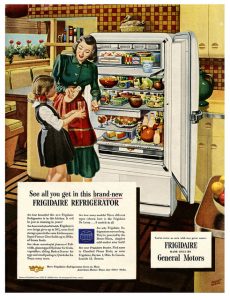I returned home this weekend from an intellectually stimulating visit to Vanderbilt University only to learn that my cherished refrigerator, once the very last word in technological sophistication, was on its last legs, its gentle and familiar purr now scratchy and uneven. Its imminent demise threw me for a loop.

What unsettled me wasn’t the prospect of having to throw out scads of food, now gone bad. After all, I was never one of those efficient balebustas who cooked soups and stews and compotes in advance and then froze them. In fact, a long running joke in the family was the disconnect between the ample size of the refrigerator and the slim pickings that typically resided inside.
In our house, the refrigerator functioned more like a billboard than a cooling system, its exterior pockmarked with tickets for and announcements of various cultural events. The disparity between the manifest and latent functions of our refrigerator even prompted a wonderful bon mot from my father who, observing the many pieces of paper which had taken root on the outside of our refrigerator, remarked that we clearly needed a bigger one.
Throwing me into a tizzy was the prospect of having to purchase a new appliance. In the many years since the last (and only) time I had had a conversation about what kind of refrigerator to call my own, the universe of options expanded exponentially. You now need a scorecard to sort out the range of possibilities, which include refrigerators with French doors and refrigerators with side-by-side doors; refrigerators that dispense ice and even refrigerators that keep Shabbat. When programmed in “Sabbath mode,” the doors of this uniquely sensitive appliance can be opened "without concern of directly turning on or off any lights, digital readouts, solenoids, fans, valves, compressors, icons, tones or alarms."
Daunted and nearly defeated, I’m put in mind of the difficulties early generations of consumers no doubt faced when it came to purchasing an icebox or their very first Frigidaire. In a strange concatenation of events, one that blurs the line between the professional and the private, I was just about to begin work on a guest lecture about the immigrant kitchen and the many challenges -- both technological and cultural -- its inhabitants faced, when my longstanding and faithful refrigerator gave up the ghost.
The lecture, I’m afraid, will have to keep. A trip to P.C. Richards awaits.

